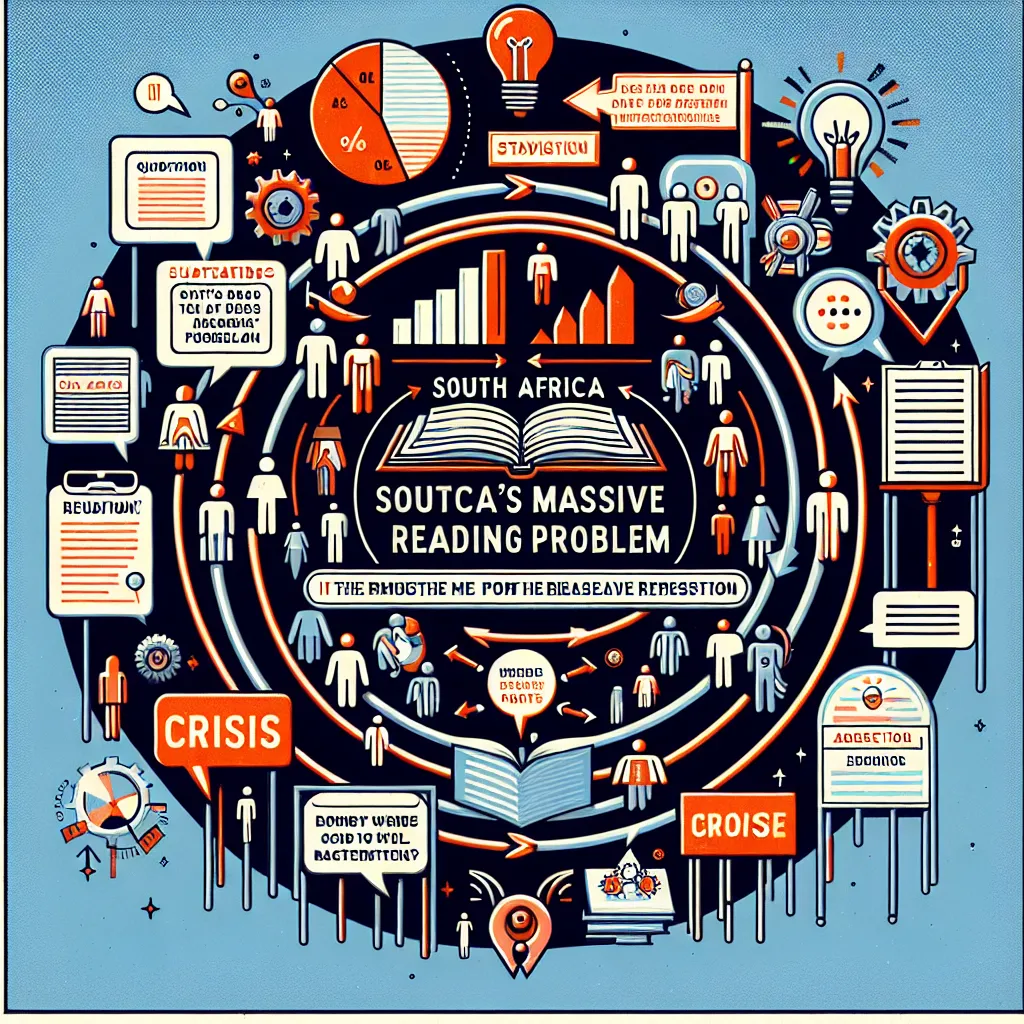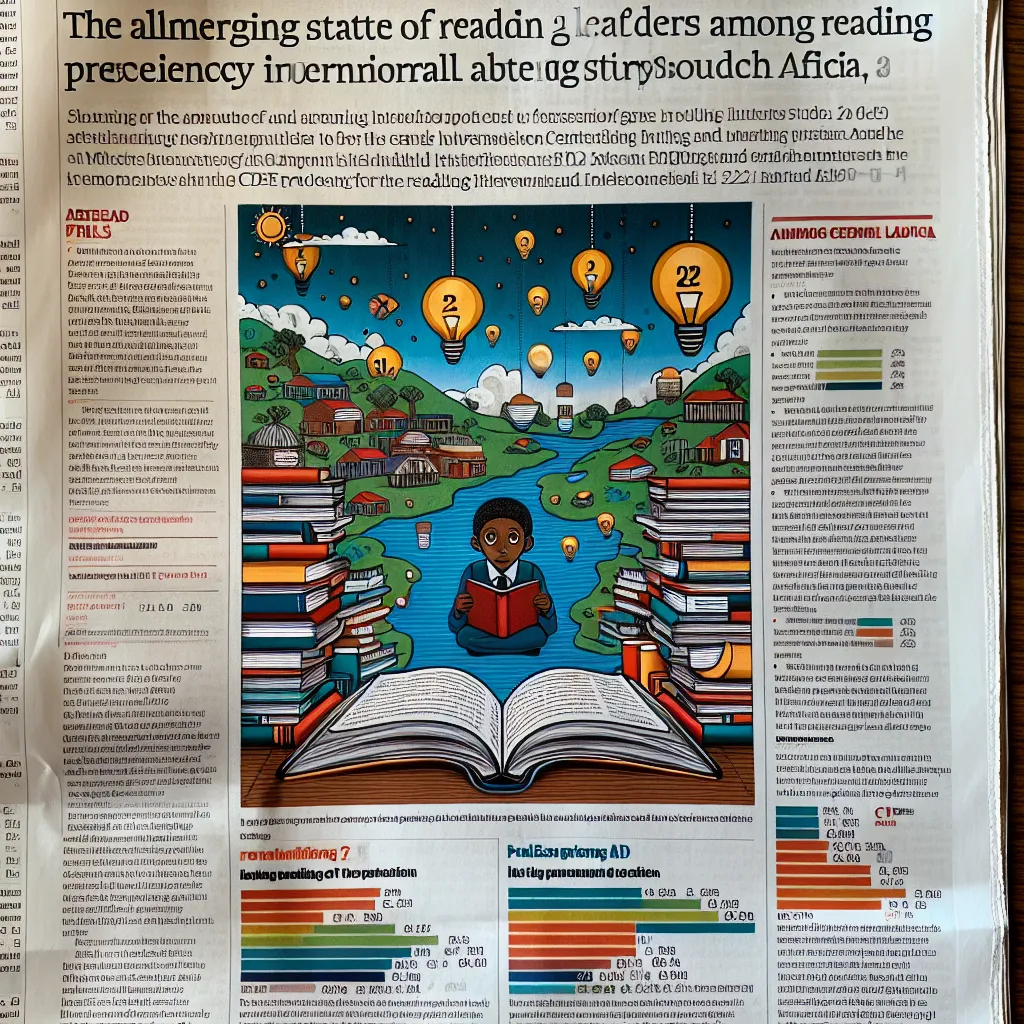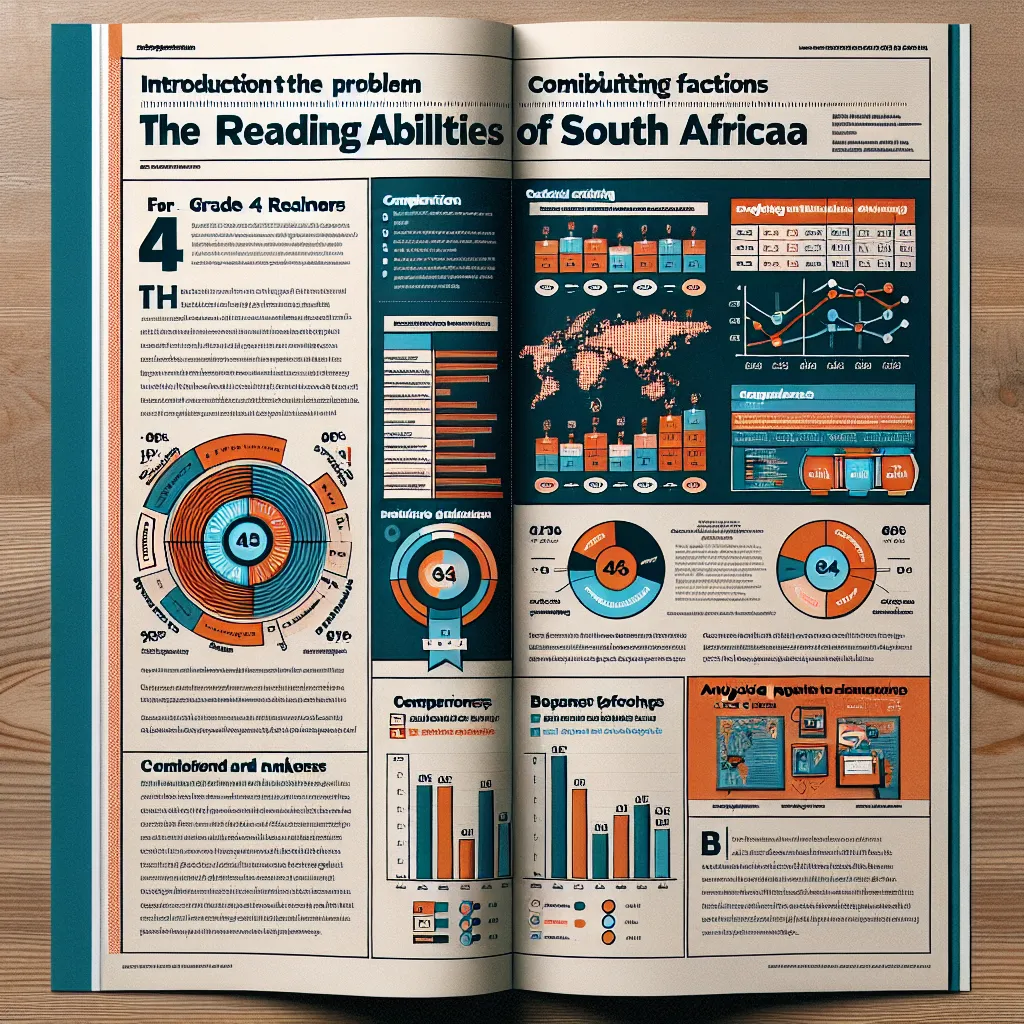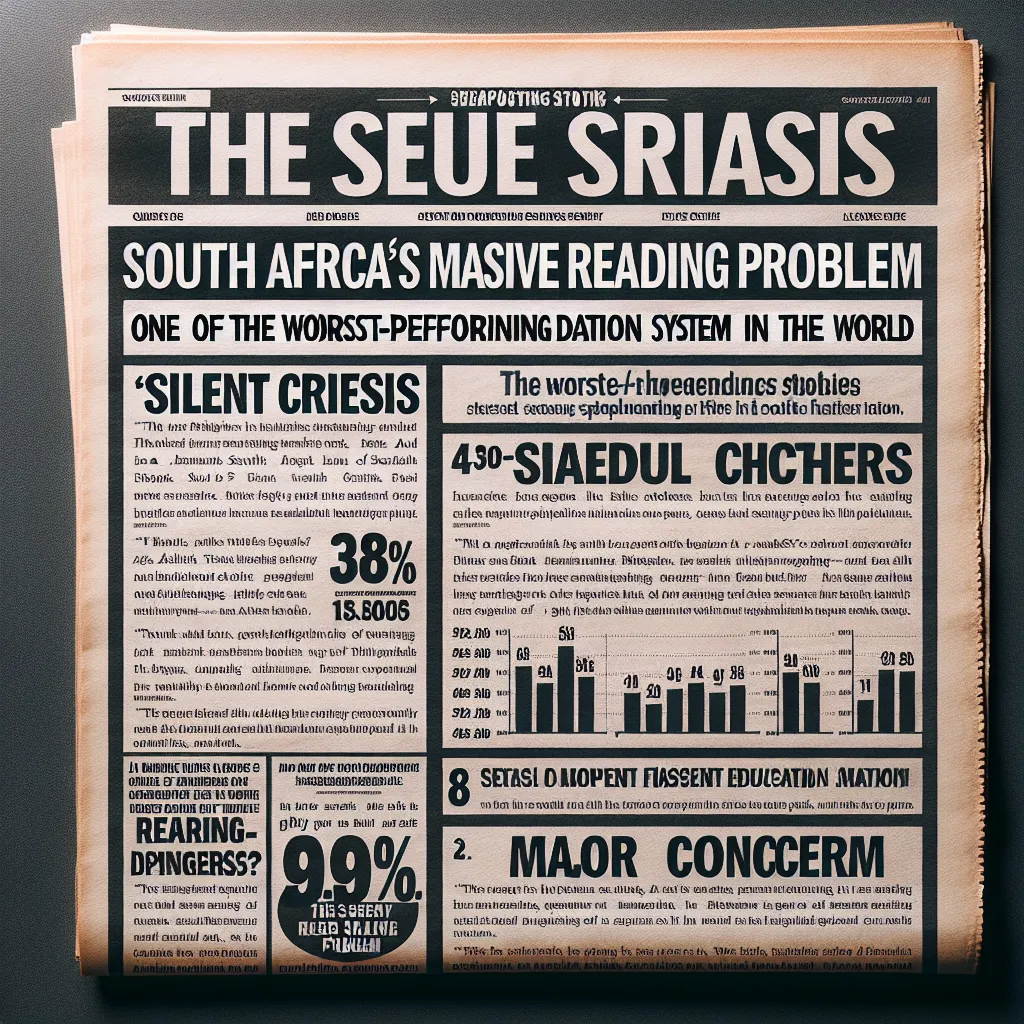Ask AI on The Internet
Question: South Africa’s massive reading problem Luke Fraser 16 May 2023 Grade 4 learners in South Africa have the worst reading ability in the world, with 81% incapable of reading for meaning. This is according to the 2021 Progress in International Reading Literacy Study (PIRLS 2021), which tested 12,426 learners across the country and compared them to students at a similar age level across 42 other nations. South Africa’s mean achievement score was 288 in the study, far below the 500 international average. Egypt was the second worst country in the study, but its score of 378 was well ahead of South Africa. A major concern for South Africa is that its achievement score has dropped significantly from the PIRLS 2016 study, where South Africa reported that 78% of children in Grade 4 could not read for meaning in any language. However, researchers noted that 21 of the 32 countries with trend data noticed a drop, with the Covid-19 pandemic having a major effect on teaching hours globally. In the 2021 study, Singapore (587), Hong Kong (573), the Russian Federation (567), England (588), and Finland (549) had the highest overall scores: The results in South Africa varied heavily across languages. Learners who were tested in Afrikaans and English scored significantly higher than those who were tested in African languages. Those tested in Afrikaans (387) and English (382) scored well above the average, while nine African languages scored below the mean, with Setswana (211) being the worstperforming language. Moreover, the Western Cape (363), Gauteng (320) and Kwa-Zulu Natal (297) outperformed the 288 mean, with more remote provinces Limpopo (244) and North-West (232) significantly lower. The biggest area of concern is that 81% of learners in the study were below the study’s low international benchmark, meaning that 81% of students cannot read for meaning. Moreover, only 11% of learners reached the low international benchmark, while 94% of students internationally could reach the low international benchmark. For South Africa, only 2% of readers could reach a high benchmark, while 1% reached the advanced benchmark. State of education The Centre for Development and Enterprise (CDE) previously said that South Africa has one of the worst-performing education systems in the world. “The President speaks of a ‘silent revolution’, while the minister talks of a ‘system on the rise’. The truth is that we face a silent crisis in our schools: South Africa has one of the worst performing education systems in the world,” said CDE’S Executive Director Ann Bernstein. The CDE said that South Africa spends roughly 13% of government revenue on education, which should improve competitive learning levels, reduce learning inequality, and train a large workforce. However, Professor Lant Pritchett said that South Africa is the biggest learning underperformer relative to GDP per capita among low and middle-income countries. CONFIDENTIAL Despite spending equivalent levels as high achieving Scandinavian countries, South Africa’s learning outcomes are worse than Kenya, Tanzania and Eswatini. Although poverty and ongoing infrastructural challenges have a debilitating effect on students, the incompetence of teachers has a massive effect on results. 80% of teachers in public schools lack the content knowledge and pedagogical skills for their subjects, For instance, the proficiency level of South African teachers (41%) is far below that of teachers in Zimbabwe (87%). Corruption is also not helping South Africa’s education system. A 2015 report by the National Education Evaluation and Development Unit (NEEDU) used to assess rural literacy found corrupt teacher hiring and promotion processes from union involvement. The “jobs for cash” scandal, as it was known, saw SADTU – the country’s dominant teacher union – get favoured individuals onto school governing bodies (SGBs) to ensure that those who paid positions could get them. The Minister of Education appointed a ministerial task team (MTT) to investigate the scandal, but Bernstein said that no government officials were prosecuted or suspended. Moreover, none of the MIT recommendations to tackle corruption have been implemented. Read: ‘Silent crisis’ at schools in South Africa – education department responds Source: South Africa’s massive reading problem – BusinessTech 12 August 2024 THIS EXAM ANSWER SHEET MUST BE TYPED. QUESTION 1: Genre, context, and register Read Text A and write a coherent and well-constructed in depth essay in which you analyse the structure, audience, tone and style of the text, to show how the writer’s purpose, which may be to inform or persuade the reader, is achieved. provide evidence from the article and make use of the important marking criteria below (100 marks) Marking criteria It is expected that you, the student, will choose from the list of persuasive techniques below, which is contained in the study materials for ENG2601, and detect, identify and discuss the application of these in the article. You may also recognise the general persuasive strategy of which the techniques are manifestations. You could then present the persuasive strategy in a thesis statement in your essay. You do not have to discuss all the techniques, or characterise them the same, but you have to write satisfactorily about the techniques that you can detect. Eventually, you are expected to construct your own arguments and support them with textual evidence, as reflected in the samples below. Emotive language: Choosing emotive words with strong connotations that express and arouse emotions and influence attitudes, for example, love, adore, hate, care and hope. Repetition: Repeating words, phrases and sentences for emphasis. Rhetorical questions: Asking questions to which no answer is required, so as to tease readers to think. (They are usually statements in the form of questions.) Generalisation: Making sweeping statements; oversimplifying; using words such as “all”; “only”, “many” to influence perceptions. Quoting experts: Lending authority to arguments. Specialist vocabulary: Using difficult technical language or jargon to impress. Case study: Referring to research to support a viewpoint. Anecdote: Using a personal experience to support a point. Hyperbole: Using exaggeration to strengthen and dramatize a situation. Euphemism: Downplaying and understating: making important things seem unimportant, or harmful things innocuous. (Title) An analysis/discussion of the use of diction and register for persuasive purposes in a media statement
**An Analysis/Discussion of the Use of Diction and Register for Persuasive Purposes in a Media Statement** In the article "South Africa’s Massive Reading Problem" by Luke Fraser, the author employs a well-defined structure, targeted audience, and specific tone and style to achieve his primary purposes: to inform and to persuade. The analysis below explores how Fraser systematically combines these elements with various persuasive techniques to emphasize the dire state of reading abilities among grade 4 learners in South Africa. ### Structure The article is structured in a logical and coherent manner, beginning with a striking statement that highlights the severity of the problem: "Grade 4 learners in South Africa have the worst reading ability in the world, with 81% incapable of reading for meaning." This introductory statement immediately grabs the reader's attention and sets the stage for the detailed discussion that follows. The article proceeds to present quantitative data from the PIRLS 2021 study, compares South Africa's performance with other countries, and discusses regional disparities within the country. It then examines potential causes and concludes with remarks about the state of education in South Africa. ### Audience The intended audience for this article includes policymakers, educators, and the general public who have a stake in the country's education system. The language and presentation of data suggest that the author aims to engage both informed readers and laypersons. By addressing a broad audience, Fraser ensures that the issue receives widespread attention, which is essential for advocating change. ### Tone and Style The tone of the article is predominantly serious and urgent, reflecting the critical nature of the subject matter. Fraser's style is straightforward and factual, which helps to convey the gravity of the situation without relying on sensationalism. The use of formal language and the inclusion of statistical data lend credibility to the arguments presented. ### Persuasive Techniques Fraser employs several persuasive techniques to strengthen his argument: 1. **Emotive Language**: The author uses emotive words with strong connotations to evoke concern and urgency. Phrases like "worst reading ability," "massive reading problem," and "silent crisis" stir emotions and highlight the severity of the issue. 2. **Repetition**: By repeating the alarming statistic that 81% of Grade 4 learners cannot read for meaning, Fraser emphasizes the extent of the problem. This repetition ensures that the reader cannot overlook the critical point. 3. **Rhetorical Questions**: The article poses rhetorical questions to provoke thought and highlight inconsistencies. For example, "How can we accept such dismal outcomes despite significant investments in education?" This question challenges the reader to consider the disconnect between spending and outcomes. 4. **Generalization**: The author makes sweeping statements to paint a broader picture of the issue. For instance, "South Africa has one of the worst-performing education systems in the world." While this generalization may oversimplify complex issues, it serves to underscore the systemic nature of the problem. 5. **Quoting Experts**: Fraser quotes Ann Bernstein from the Centre for Development and Enterprise to lend authority to his argument. Bernstein's statement that "we face a silent crisis in our schools" reinforces the urgency conveyed by the author. 6. **Case Study**: The PIRLS 2021 study serves as a case study that provides concrete evidence to support Fraser's claims. The detailed data from the study add weight to the argument and make the issue more tangible for the reader. 7. **Hyperbole**: The article uses hyperbole to dramatize the situation, such as referring to the reading problem as "massive" and the state of education as a "silent crisis." This exaggeration helps to capture the reader's attention and emphasize the urgency of the problem. 8. **Euphemism**: The author avoids euphemisms, opting instead for straightforward language that conveys the stark reality of the situation. This choice ensures that the reader fully grasps the seriousness of the problem without being misled by understated language. ### Conclusion Fraser's article effectively combines structure, tone, style, and persuasive techniques to inform and persuade the reader about the critical reading challenges faced by South African learners. By presenting detailed data and leveraging various rhetorical strategies, Fraser successfully highlights the severity of the problem and calls for urgent attention and action from policymakers, educators, and the public. The overall impact of the article lies in its ability to present a compelling case for educational reform and to mobilize stakeholders to address the underlying issues that contribute to the country's reading crisis.
Think your answer is better than the AI's? Post it below.
Question Tags
If you want your question answered by an AI, click here.







Post your own comment: